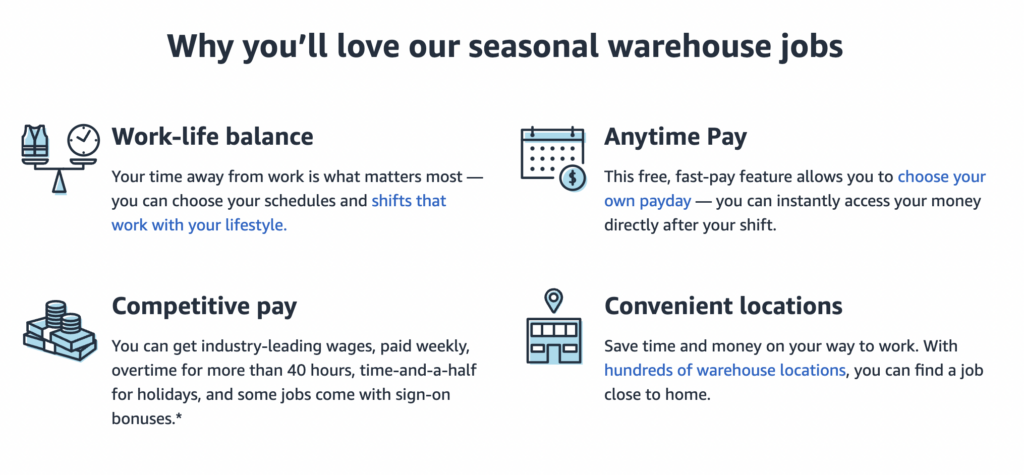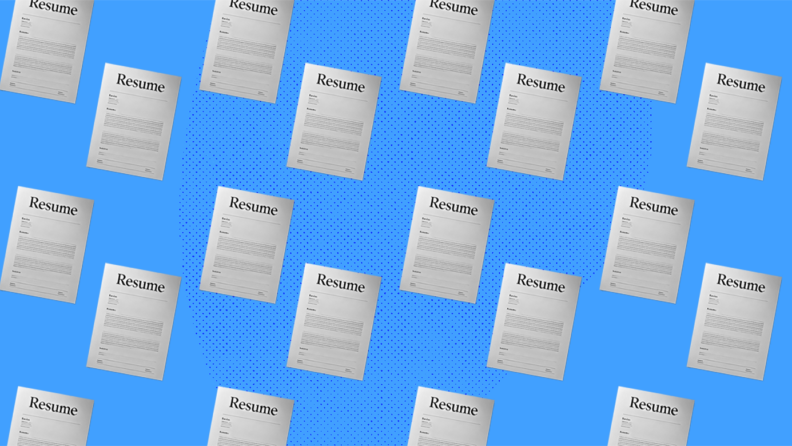If recruiting normally is tough, high-volume recruiting cranks it up to another level. Use this guide to help you efficiently hire the candidates you need.
What Is High Volume Recruiting?
High-volume recruiting, also known as mass hiring or bulk hiring, refers to the process of recruiting large numbers of candidates within a relatively short period.
This type of recruiting is common in industries or companies that experience rapid growth, seasonal demand, or require a large workforce to handle specific projects.
High-volume recruiting often occurs in sectors like tech, retail, hospitality, customer service, manufacturing, and logistics, especially during peak seasons, when opening new locations, or after a successful funding round or IPO.
Example: High-Volume Recruiting For A New Data Center Launch
Company: ABC Tech
Situation: ABC Tech, a leading cloud services provider, is opening a new data center in a major metropolitan area. The company needs to hire 500 new employees within six months to staff various roles, including data center technicians, network engineers, IT support staff, and facility management personnel.
Strategy: ABC Tech’s HR team works closely with the data center operations and IT departments to determine the exact number of positions needed, the skills required for each role, and the timeline for hiring.
This includes creating detailed job descriptions and defining the qualifications for each position and compensation packages on offer.
From here, they created candidate personas for different roles they used to inform candidate sourcing, the SEO strategy for job ads, and recruitment marketing efforts.
They also designed specific interview processes for different roles including the number of interviews, assessments, and selection criteria.
Outcome: ABC Tech successfully hires 1,000 highly skilled employees within the six-month timeframe, enabling the new data center to become fully operational on schedule.
The well-coordinated high-volume recruiting strategy not only fills the necessary roles but also strengthens ABC Tech’s employer brand as an employer of choice in the tech industry.
This example shows how a tech company can effectively manage high-volume recruiting by leveraging staffing technology, industry partnerships, and a structured approach to attract and hire a large number of skilled professionals.
High Volume Recruiting Vs Corporate Recruiting
High-volume recruiting focuses on quickly hiring a large number of candidates, often for similar roles, using standardized processes and automation.
In contrast, corporate recruiting targets specific, often higher-level positions, with a personalized and relationship-driven approach that emphasizes quality and fit over speed.
While high-volume recruiting prioritizes efficiency, corporate recruiting is more about precision and customization.
Which Industries Rely On High Volume Recruiting?
Industries that rely heavily on high-volume recruiting include:
- Retail
- Hospitality
- Customer service/call centers
- Manufacturing
- Logistics and warehousing
- Healthcare (e.g., nursing, support staff)
- Food service and restaurants
- Seasonal agriculture
- Construction
- Technology, including IT support
These industries often need to hire large numbers of people quickly due to seasonal demand, rapid growth, or specific projects.
Note: If you operate in one of these industries and are looking for some extra recruiting muscle, we may be able to help! The first step would be to check out our list of the best IT recruiting agencies or other specialty staffing augmentation services to find the right fit for your needs.
What Are The Challenges Of High-Volume Recruiting?
1. Finding suitable candidates
Finding enough people for high-volume recruiting can be a challenge because the demand for candidates may exceed the available talent pool, especially for specialized roles.
This can lead to increased competition, longer time-to-fill, and the need for broader or more creative sourcing strategies to attract sufficient applicants.
2. Managing lots of candidates
Handling a large number of applications can overwhelm recruitment teams, making it challenging to assess candidates and maintain timely communication. This can result in delays and missed opportunities and create a bad candidate experience.
However, implementing a robust applicant tracking system (ATS) and recruitment automation tools can help keep the process organized and efficient.
-

Recruit CRM
Visit WebsiteThis is an aggregated rating for this tool including ratings from Crozdesk users and ratings from other sites.4.8 -

ClearCompany
Visit WebsiteThis is an aggregated rating for this tool including ratings from Crozdesk users and ratings from other sites.4.6 -

Boon
Visit WebsiteThis is an aggregated rating for this tool including ratings from Crozdesk users and ratings from other sites.4.7
3. Time constraints
High-volume recruiting often comes with tight deadlines, which can pressure recruiters to make quick decisions.
This urgency can lead to rushed hires and reduced vetting, negatively impacting recruitment metrics such as quality of hire.
To help maintain quality, it's beneficial to establish a clear hiring criteria with standardized interviews and assessments, combining automated tools with thorough human review.
Also, proper recruitment planning and the right technology can help manage these time constraints effectively.
The High-Volume Recruitment Process
To find new talent and handle so many applications in such a short space of time, each stage of the high-volume recruitment process—application, interviewing, and selection—requires a tailored approach.
Here’s an overview of each stage, along with some best practices:
1. Application stage
Objective: To attract and filter a large number of applicants efficiently.
Best practices:
- Clear job descriptions: Craft clear and concise job descriptions that outline essential qualifications, responsibilities, and expectations. This will help reduce the number of unqualified applications.
- Pre-screening questions: Use pre-screening questions in the application process to quickly assess whether candidates meet the basic requirements. You can then auto-reject candidates that don’t meet specific criteria e.g. location, visa status.
- Automated assessments: Automated assessments can help streamline high-volume recruiting by efficiently pre-screening and evaluating candidates based on relevant skills and qualifications, enabling faster, objective decision-making.
- Mobile-friendly applications: Ensure that your application process is easy and mobile-friendly, as many candidates may apply through their smartphones.
2. Interviewing stage
Objective: To assess a candidate’s suitability for the role through structured interactions.
Best practices:
- Structured interviews: Develop a standardized set of questions and assessments aligned with the job’s requirements. This ensures consistency and fairness in evaluating candidates.
- Group interviews: For high-volume recruitment, consider group interviews to evaluate multiple candidates at once. This can save time and resources.
- Interview scoring systems: Use scoring sheets to objectively assess each candidate’s responses. This helps in reducing bias and making comparisons easier.
3. Selection stage
Objective: To identify and choose the best candidates for the role.
Best practices:
- Offer management: Be prepared to extend offers quickly. Use pre-prepared offer templates and consider making conditional offers to expedite the process.
- Collaborative decision-making: Collaborative hiring involving multiple stakeholders in the selection process helps to ensure a well-rounded decision. Different perspectives can provide a more complete assessment of a candidate’s fit and minimize bias, but be wary of adding too many interviews and ensuring feedback is timely.
- Timely feedback: Communicate decisions to candidates promptly. In high-volume recruitment, delays can result in losing top candidates to competitors.
Additional tips
- Continuous improvement: Regularly review and refine your recruitment process based on feedback and outcomes. What works for one recruitment drive may not work for another.
- Candidate experience: Even in high-volume recruitment, maintaining a positive candidate experience that isn't too draining is important for your employer brand. Provide timely updates and clear instructions at each stage of the process.
7 Best High-Volume Recruiting Strategies
1. Clearly define your recruitment process clearly before you get started
Things are about to get hectic. Creating a clearly defined process before things kick off should make it more efficient and consistent and help prevent everyone from losing their minds.
“You absolutely must map out the candidate journey”, says Simon Royston, Founder and Managing Director of The Recruitment Lab, “How will you communicate with candidates, what messages are you giving them, and what are the stages that have to be completed before they actually start work? You are not dealing with one person that you can give flexibility to… you are running a process that needs to accommodate possibly hundreds of candidates.”
A clear process also aligns internal teams and ensures everyone knows their role and what’s expected of them.
2. Create a compelling employer value proposition (EVP)
Creating a compelling employer value proposition (EVP) is crucial in attracting and retaining the right talent for you.
Your EVP should clearly communicate what makes your company an attractive employer, reflecting your unique culture, values, mission, benefits, and facilities.
Best practices:
- Tailored: Customize your EVP to appeal to the specific talent you want to attract, highlighting aspects like flexibility, compensation, or growth potential.
- Consistency: Ensure your EVP is reflected consistently across all touchpoints, from job postings to the interview process and onboarding.
- Feedback loop: Regularly gather feedback from current employees and also candidates to refine and enhance your EVP, ensuring it remains relevant and attractive.

3. Develop a targeted recruitment marketing strategy
Recruitment marketing is how you promote both your brand and open roles. Some best practices in the case of high-volume recruitment:
- Identify your audience: Define the specific demographics, skill sets, and experiences you’re targeting and create personas that represent your ideal candidates. This helps craft tailored messaging that resonates with different segments of your audience.
- Channel selection: Choose recruitment channels based on where your target candidates are most active. This could include specific job boards, social media platforms, industry-specific sites, and professional networks like LinkedIn can be useful.
- Programmatic ad platforms: Use programmatic job advertising platforms that automatically place your job ads on the best-performing sites and adjust in real-time based on performance.
Specialist recruitment marketing software can help you identify channels, post ads, and track the effectiveness of you efforts.
4. Nurture your employer brand
Related to your EVP is your employer brand i.e., how you’re perceived as an employer by the wider world.
Carefully nurturing your brand and showcasing what you offer as an employer will help you to attract the right candidates.
“It’s really important to have a strong employer brand, especially for high-volume recruitment,” says Vit Koval, Co-founder of Globy, “Candidates should be well aware that they are entering a good company with a positive work culture.”
Best practices:
- Consistent messaging: Use job posting software to ensure that your employer brand messaging is consistent across all platforms, including your website, social media, and job postings.
- Employee advocacy: Encourage current employees to share their positive experiences and stories on social media. Employee testimonials and reviews on platforms like Glassdoor can significantly impact your brand perception.
- Engaging content: Create engaging content that showcases your workplace culture, career growth opportunities, and the impact employees have within the company.
- Awards and recognition: Apply for workplace awards and recognition programs as being recognized as a "Best Place to Work" or similar helps boost your employer brand.
- Career development opportunities: If appropriate, emphasize career development opportunities and continuous learning in your branding.
- Patience and authenticity: Reputations take time to build (but no time to ruin) so be patient and authentic in your approach.
5. Use existing employees to help recruit
If you’re a good employer, then it shouldn’t be too difficult to encourage existing employees to refer potential candidates.
As Randy Tosch, VP Talent at Grainger, highlights “Candidates who are referred by current Grainger team members often end up doing well when they join the company. Current team members understand what is needed and are often great at spotting talent.”
You can sweeten the deal by offering incentives as part of an employee referral program.
6. Utilize talent rediscovery
Hopefully, you have a candidate database you can draw upon to re-engage past candidates and employees and match them with current job openings (if not, I'd recommend considering investing in candidate database software or a recruiting CRM).
Best practices:
- Regular outreach: Periodically reach out to past candidates with updates about your company, new job openings, and other relevant information.
- AI and automation: Use AI recruiting tools to analyze your existing talent pool and automatically match past candidates to new job openings based on updated job descriptions and candidate profiles.
- Candidate nurturing: Treat past candidates like leads in a sales funnel. Nurture them through targeted content, job alerts, and personalized communication to keep them engaged with your brand.
7. Create partnerships with institutions
Creating partnerships with institutions like universities, colleges, and technical schools can help streamline high-volume recruiting by providing access to a large and diverse talent pool, especially for entry-level or specialized roles.
Such partnerships allow companies to build long-term pipelines of qualified candidates, engage in targeted recruiting efforts, and establish a strong employer brand among students and recent graduates.
“When taking on larger commercial projects, I recruit recent trade school graduates and provide on-the-job mentorship,” says Francisco Romero, CEO of Romero Hardwood Floors Inc,“New hires work with senior installers for several weeks to learn proper techniques and standards and regular feedback helps determine if recruits should be brought on permanently.”
Best practices
- Participate in on-campus recruiting events: Engage in career fairs, networking events, and workshops hosted by institutions to directly access large groups of potential candidates in one place and promote your brand.
- Collaborate on curriculum development: Partner with institutions to influence curriculum design, ensuring that students develop skills that align with your company's needs, thus reducing onboarding and training time for new hires.
- Leverage alumni networks: Use alumni associations to tap into both recent graduates and experienced professionals for recruiting, widening the talent pool for high-volume and diverse hiring needs.
Automating High-Volume Recruitment
Modern recruiting technology is very much your friend to help you streamline the recruitment process and deal with large volumes of candidates efficiently.
“If you're handling everything by hand, high-volume recruiting can be extremely exhausting. That's why automation is so handy in this situation,” says Susan Andrews, HR Consultant at KIS Finance. “For example, an applicant tracking system can help handle job postings, resumes, and initial screenings. It kept me from burning out and saved me a ton of time.”
Here’s what’s possible:
1. Applicant tracking system
- Create job ads and post them across different boards and social platforms.
- Automate candidate screening based on criteria such as location or visa status.
- Resume scanning software to help extract information.
- Perform bulk actions (emails, interview scheduling) with some level of personalization.
- Help hiring teams see what's required of them and when and automate prompts e.g. "We're waiting for your interview feedback".
2. AI-powered chatbots
- Use to answer FAQs 24/7 and provide assistance with application submission.
3. Automated interview scheduling
- Interview scheduling software with self-scheduling tools for candidates to book interview slots.
- Set up automated interview reminders.
- Integrate video interview platforms with scheduling tools.
4. Automate communication with candidates
- Use candidate sourcing software to automate outreach.
- Set up automated email sequences for updates.
- Personalize automated messages for a better experience.
- Use SMS or push notifications for quick updates.
5. Deploy programmatic job advertising
- Automate ad placement based on candidate behavior.
- Use dynamic ad content tailored to the candidate.
- Track ad performance and optimize automatically.
6. Analytics and reporting automation
- Set up automated reports for key recruitment metrics. This is something to look out for in enterprise recruitment software particularly.
- Use real-time dashboards to track recruitment performance.
- Implement predictive hiring analytics software for future hiring needs.
High Volume Recruitment Metrics
High-volume recruiting is a constant battle between speed and quality. Here are some metrics to help you hire better people faster:
1. Time to Fill/Time to Hire
The average time it takes from posting a job opening to a candidate accepting the offer.
This helps measure the efficiency of your recruitment process. In high-volume recruitment, reducing time to fill is crucial to avoid losing top candidates to competitors.
The time taken from when a candidate enters the recruitment funnel (e.g., submits an application) to the time they accept the job offer.
Indicates the speed and efficiency of your internal processes, from screening to final selection.
2. Cost per hire
The total cost involved in hiring a new employee, including advertising, recruiter time, assessments, and onboarding.
This is essential for budgeting and understanding the financial impact of your recruitment efforts, especially when scaling hiring processes.
3. Applicant-to-hire ratio
This is the number of applications received compared to the number of hires made. It provides insights into the effectiveness of your sourcing strategies and the selectiveness of your screening process.
4. Offer acceptance rate
The percentage of candidates who accept your job offer out of the total offers extended. A low acceptance rate may indicate issues with your offer competitiveness, candidate experience, or employer brand.
6. Candidate drop-off rate
The percentage of candidates who start but do not complete the application process or withdraw during the recruitment stages. This helps identify stages in your recruitment process where candidates are losing interest, allowing you to make necessary adjustments.
7. Source of hire
Tracks where your hires are coming from, such as job boards, social media, employee referrals, or career sites. Understanding the most effective sources helps optimize your recruitment marketing spend and focus efforts on the most productive channels.
8. Quality of Hire
Measures the performance and retention of new hires over time, often assessed through performance reviews, time to productivity, and retention rates. Tracking helps ensure that your high-volume recruitment efforts are not only filling positions quickly but also bringing in high-quality talent.
9. Candidate satisfaction
Measures how satisfied candidates are with the recruitment process, often gathered through post-interview surveys or feedback forms. Called the candidate net promoter score, a high score indicates a positive candidate experience.
11. Application completion rate
The percentage of candidates who start and complete the application process. A low completion rate may indicate that your application process is too long or complex, leading to potential drop-offs.
12. Recruiter efficiency
The number of hires a recruiter makes within a specific period, often measured by the number of interviews conducted, offers made, and hires secured.
This measures the productivity and effectiveness of your recruitment team, helping to identify areas for improvement or the need for additional resources.
13. Interview-to-offer ratio
The ratio of the number of candidates interviewed vs the number of offers extended. A high ratio may indicate inefficiencies in the candidate screening process, while a low ratio suggests effective candidate selection.
18. Recruitment Funnel Efficiency
Measures the efficiency of each stage in the recruitment funnel, from application to hire. Provides a holistic view of the recruitment process, helping to identify and address inefficiencies at specific stages.
14. Candidate pipeline conversion rate
The percentage of candidates who move from one stage of the recruitment process to the next, ultimately leading to a hire. Helps identify bottlenecks or stages where candidates are being filtered out in large numbers.
15. Employee referral rate
The percentage of hires that come from employee referrals. High referral rates often correlate with higher quality of hire and better cultural fit, reducing turnover.
Remember, Hiring Is About People
In the chaos of a hiring sprint, it can be hard to remember that people aren’t, as Mariya Hristova puts it in her excellent article on the candidate experience, “Numbers in a Lotto drawing machine.”
While no process is perfect, try your best to ensure that nobody is left in the dark regarding their application, especially if they’ve completed an assessment or interviewed.
This is something cloud recruitment software can help with to balance automation with the personal touch.
The better the quality of feedback you can provide, the better the experience for candidates and this will help you out with hiring in the future.
Join The People Managing People Community For More Insights
For more guidance on high-volume recruiting and talent acquisition in general, join our supportive community of HR and business leaders sharing knowledge and best practices to help you grow in your career and make greater impact in your organization.





